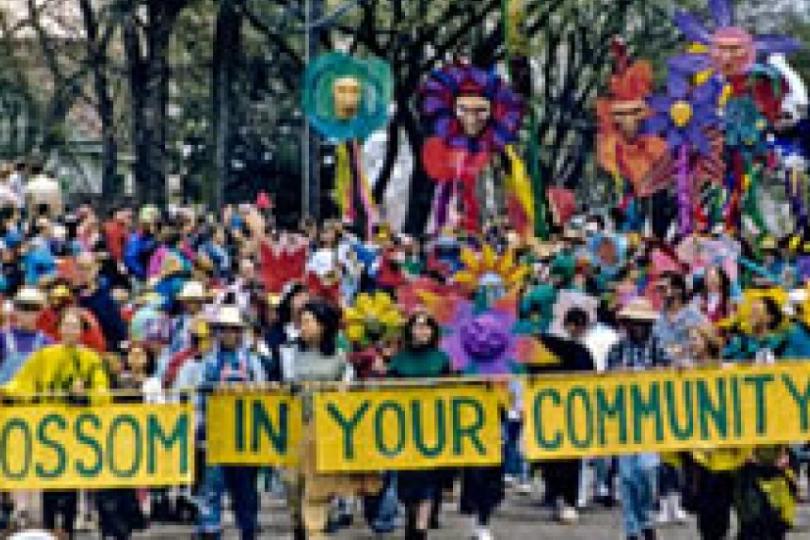Creative Placemaking: Logic Models and Love
Editorial

Sunday was the MayDay parade and festival in Minneapolis. It is, quite literally, my favorite day of the year. Full of joy and giant puppets and thousands of people (it’s one of the largest May Day parades in the world!) It makes me proud to live here, connects me deeply to my community, and gives me hope for humanity - it’s that special.
I know without a doubt that the May Day parade is effective creative-placemaking. It’s about neighborhood identity, and vibrancy, and economic and community development. It’s also a big, beautiful, co-created mess of puppets and music and dancing and food and random weirdos, and children running everywhere, and crowds and vendors and solemn ceremony and wild abandon. It means a lot of different things to a lot of different people.
There’s been some really thoughtful discussion in-person and online this week about the outcomes and metrics of creative placemaking. (If you haven’t read Ian David Moss’s Createquity piece, you really should be doing that instead of reading my ramblings.) Of course, this discussion interests me, it is core to the work I care deeply about. I also struggle to think of anything useful to contribute or to see how it might change what happens on the ground.
I also had the opportunity this week to spend some intense professional development time studying logic models. I hate logic models. For me they are, somehow, simultaneously too reductive and too complex. Too simple, too linear for how I think the world works and too dry, too chart-y for how beautiful the world is. They make me irrationally grumpy.
Both the metric conversation and the logic model training made me feel a little anti-academic (troubling for the child of two professors) and more than a little stubborn and petulant. Then I think about the May Day parade. It’s so obvious that this is a quality experience that it makes me feel like saying, “I know it when I see it!” - that old axiom that’s been used to describe porn and quality art...and sometimes the confusion of the two. Obviously, “I know it when I see it” isn’t enough. So, I’ve been trying to see if I can come up with a tool that encapsulates how we know it when we see it. Because we all do, right? We know the experiences that make us feel attached to our place, connected to our neighbors - that give us that unmistakeable sense of community. We know the kinds of places we want to live - places that have those wonderful opportunities to, as Carol Coletta says, “stumble in to the fun.”
With apologies to my academic colleagues, here’s my logic model for effective creative placemaking:
artists --> love --> authenticity = places where people want to gather, visit & live
Anyone can measure these things just by participating or observing:
artists: Art comes from artists, right? And (as anyone who has ever been within shouting distance of me knows and is probably tired of hearing) I mean the broadest possible definition of artists - people who create, people who make, people with big, beautiful ideas. Are artists involved? Are people creating things? Did someone make something or make something happen?
love: Love is what gives us quality - not necessarily artistic quality as defined by curators, or markets or other recognition; but the quality that comes from care and dedication and focus. Is there joy? Is there a sense of possibility and passion? C’mon, Dr. Economist, I know you can feel it. Artists are good at love. (also? Oh my god! I put “love” in a logic model. Deal with it.)
authenticity: Is there good food there? Can I buy a homemade spring roll or a local beer? Authenticity is what makes us know where we are. There has to be something uniquely of this place to connect to it. Are residents of the neighborhood involved? Does the experience reflect its location?
I’ve actually applied this tool to the experiences and projects that my gut tells me are effective creative placemaking, and you know what? It works for all of them. It works for the Millenium Bean, Parking Day, New World Symphony’s Wallcast Concerts, Improv Everywhere No-Pants subway ride, Trey McIntyre, Paint the Pavement, Legion Arts, everything Theaster Gates touches, the Hotel Donaldson, Project Row Houses, Spoonbridge and Cherry, and my beloved MayDay parade.
I also easily came up with examples of projects that have one of the 3 ingredients missing, and to my mind don’t achieve success because of it. I’m way too Midwestern to list those here--but I imagine you can come up with your own list. We’ve all been to a craft fair that has art and is rooted in a particular neighborhood but lacks love, right? There have been some very public recent examples of artists with great love for a project but a lack of depth of understanding about the community in which they wanted to work--you need the authenticity. And community garage sales are effective community builders, but without artists, I wouldn’t call that creative placemaking.
I also applied it to an Irrigate mural project on a furniture liquidator store on University Avenue, that I affectionately christened “Bears in Chairs”
Artists? Yes. Timm Brazil is an artist from the neighborhood who paints in his home studio. He may never have created a public work before this, but he’s definitely an artist.
Love? Yes. Timm was completely dedicated to this project, spending hours to determine what the store owner wanted and needed for their business and then hours to complete it before the winter came. He talked with passersby about his work, their neighborhood, engaging them in his process.
Authenticity? Yes. This mural is on a a furniture store and it is a mural of bears sitting in chairs (also beds, but that’s doesn’t rhyme as nicely.) Obviously, not all experiences have to be this literal to be authentic, but there’s no denying that you know more about this store and this place, when you walk by this piece of art.
So, to all our funders and colleagues and stakeholders - please don’t be alarmed - I have many people who are much smarter than I am helping us understand the metrics and evaluation of our work (including some really interesting thinking around developmental evaluation that we’ve being doing with Richard Evans). But along with those other metrics, I’m also going to be using this one:
artists --> love --> authenticity = places where people want to gather, visit & live
I think this is important because for this movement to succeed, it’s not enough to prove we’re valuable on paper (although that would be a huge step forward), we have to actually be valuable in a way that people can see and get because it feels real. The kind of value that is unquestionable because we were there. There’s no logic model in the world that can capture how a crazy parade can restore my faith in humanity. In the end, it’s not that we know it when we see it; it’s that we know it when we feel it.






